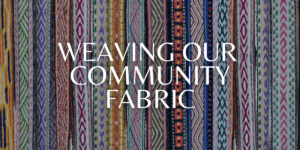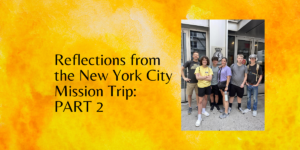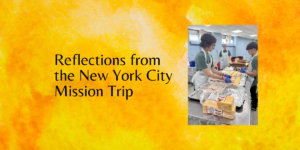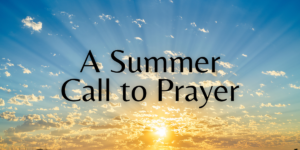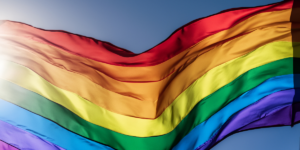The St. John’s Pulpit
St. John’s Baptist Church 300 Hawthorne Lane Charlotte, NC 28204
704.333.5428 www.stjohnsbaptistchurch.org
CAN YOU SEE HOPE FROM HERE?
Isaiah 2:1-5 and Romans 13:11-14
First Sunday in Advent, December 1, 2019
by Senior Minister, Rev. Dennis W. Foust, PhD
For more than 25-years, Paula and I loaded our vehicle to be ready to leave after Christmas Eve worship. Our destination was the home of grandparents three states away. While I greeted folks after the service, the kids went to my office where they put on their pajamas; then, off we would go. We still discuss those trips and ask, “What were we thinking?” One year, we drove for miles in such a heavy fog that we couldn’t see the front of our own car.
Some of you are entering this new Christian Year in a dense fog. Within the branches of our Church Family Tree, on this first day of Advent, burdens and griefs hover like dark clouds. One family is carefully monitoring two family members after a kidney transplant; a mother recipient and a daughter donor. One family is trying to exhale while their 31-year-old daughter and mother of two preschoolers is entering treatments for stage four colon and liver cancer. Other families are evaluating long hospital stays and infusion treatments or arranging their home for hospice care. These are only a few of our households living in the midst of heavy fog and storms, as we begin a new year focused on hope.
We are touched by the words of Emily Dickinson who wrote,
“Hope is the thing with feathers
That perches in the soul –
And sings the tunes without the words – and
Never stops at all.”
The stories of this season involve many journeys in the fog. After Mary received her news, she set off to visit Elizabeth in the fog. When she arrived at her cousin’s home, she found Elizabeth living in a fog as well. Elizabeth’s priest of a husband, Zechariah, couldn’t even speak. Mary’s betrothed, Joseph, lived in a fog finding a few searchlights during his dreamy sleep. Joseph and Mary made a journey to Bethlehem in a fog. Metaphorically speaking, Jesus was born in a fog, as Herod sought to kill him by murdering the innocents.
Wise Men from the East journeyed in a fog guided by a lonely star.
After Jesus’ birth, Joseph and Mary became refugees running for their lives to escape violence fleeing into Egypt, where they lived in a fog for Jesus’ early preschool years.
You begin each day in conversation with God, acknowledging your commitment to follow the Light of Jesus; recommitting yourself to be his vocational disciple serving the mission of God’s vision as a Minister in Daily Life. You then retrieve your paper or log onto your digital device or turn on the television to see headlines of war, violence, corruption, murder, political childishness, terrorism and treachery. Each day, it seems, the fog tries to smother the brightness of the sunrise. You may turn to the sports page or ESPN to avoid the negative news. There, you see the story of Myles Garrett hitting Mason Rudolph over the head with a helmet or a fight between the Lakers and Rockets and view a picture of a 10-year-old boy holding his 6-year-old brother who is in tears watching the players fight.
As you love God by following the Way of Jesus guided by God’s Holy Spirit, you serve the mission of God’s vision. Yet, you do so while violence, terrorism, destruction, political partisanship and eruptions of anger create fog.
You accept this as reality; human life has always been this way.
The Hebrew people started the biblical story of violence among humanity with the first family as Cain’s jealousy exploded into his murder of Abel. Isaiah told us that reality involves both sword and plowshare, spear and pruning hook, wartime and peacetime.
It has been proposed that God gives us two eyes so we can see both extremes of reality; God’s ways and the ways of human sin and selfishness.
The hope that sings within you is not based on a strong economy, military might or nuclear weaponry. We understand Albert Einstein who wrote, “I know not which nations will fight in World War III, but World War IV will be fought with sticks and stones.” We can be certain, at the end of a nuclear war, we will not know who is right; only who is left.
When Isaiah offered his vision of hope, it was a time of tremendous political confusion and international fog. In 742 B.C. Isaiah’s country, Judah, was threatened by the powerful nation of Assyria. The Assyrian king, Sennecharib, with his menacing armies, terrorized Judah. Assyrian swords and spears were arrayed in massive numbers against the king of Judah. Yet, Isaiah had the audacity to say to his own King Ahaz, that he could SEE hope from there; he could SEE God’s hope in the fog.
How do you SEE hope in today’s fog? What does hope look like to you?
Isaiah saw hope like a vision where tools of war, swords and spears, were transformed into tools of peace, plowshares and pruning hooks. During war, the fields and vineyards lay desolate. People go hungry and rivers run red. But, in times of peace, the hungry are fed and rivers run clear. Isaiah points toward a day when swords SHALL be beaten into plowshares and spears SHALL be forged into pruning hooks. He tells of a day when many people will approach the Lord to learn God’s ways. He tells of a day when all war colleges will have a sign at the gate reading, “Closed,” because nobody is studying war no more.
In the Lord’s Prayer, Jesus taught us to pray, “Thy kingdom come, Thy will be done on earth as it is in heaven.” In this vision of God’s kingdom, there are no swords, no spears, no war no more. Paul reminded the early Church to pursue this vision.
Today, he would say, “stay woke.” Put down the tools that do darkness’ work.
Put on the Light.
Leave behind carousing, drunkenness, gluttony, self-indulgence, quarrelling and jealousy.
We must keep this hopeful vision alive in our generation. Let us encourage and work for this vision of transforming the efforts of evil into the works of God’s good. In our words and deeds, in our efforts and relationships, we must keep this hope alive in our view of the world. We must remember that the Church also contributes to the world’s violence and greed. As we practice the Way of Jesus, we are able to SEE God’s hopeful vision.
Former President and Supreme Allied Commander during World War II, Dwight Eisenhower, encouraged an alternative to war and violence. Eisenhower said, “every gun that is made, every warship that is launched, every rocket fired, signifies in the final sense a theft from those who hunger and are not fed, those who are cold and are not clothed… this world in arms is not spending money alone. It is spending the sweat of its laborers, the genius of its scientists, the hopes of its children. There has to be a better way.”
Church, we need to rethink the costs of violence and war. Over 100 million people died in wars in the 20th century when you include the deaths from the related diseases, famines and genocides. Over 200 wars have been fought since 1945. Most of the weapons for these wars have been sold by industrialized nations including the United States. For the cost of training and outfitting and feeding one soldier for three years in the military, you could educate more than 120 children through college. The cost of one nuclear missile submarine is the equivalent of 450,000 average houses which could house more than 1 million people.
In Washington, D.C., there is a 16 ft. x 19 ft. plowshare. Welded to this plowshare are 3,000 disabled handguns confiscated by the D.C. police. The inscription on the sculpture reads: “Guns Into Plowshares.” It has been moved from its original site to a remote location.
Elias Chacour is an Arab who grew up in Galilee. Now a Greek Orthodox priest in Jerusalem, he lives in the terrible conflict of the Middle East. Chacour does not push for the rights of Arabs alone, but for all people. He walks down the street with a Muslim Imam on one side and a Jewish Rabbi on the other. He says: “Over the years, I have developed a consciousness that my real community can only be Jews, Christians ND Muslims living together in love.
We must beat our swords into plowshares, our spears into pruning hooks.”
Beloved, Advent is not the retelling of a ‘Once Upon a Time,’ story. When we show people love in the midst of hate, we reveal to people that we are SEEING hope from here. When we express compassion, we help people journey through the fog of condemnation. When we offer forgiveness and kindness, we show to others God’s hope. When we relate in the way of Jesus to people of diverse skin colors, cultures, religions, political persuasions, and belief systems, they notice how we repent of our own sin and how we seek to understand one another and how we forgive others for sinning against us. When we live in the hope of God amidst our burdens and griefs, we show that we SEE God’s hope through the risen Christ.
It is Advent. People are searching for hope May they see us with hammers in hand beating swords into plowshares and spears into pruning hooks. May they see us transforming bitterness into mercy; grudges into forgiveness; dollars into meals; hours into houses; disease and death into healing through death, and despair into embraces of God’s grace.
Beloved, today, on this first day of a new Christian Year, let us ask God to show us the places in our lives that need to be transformed by God’s hope; the things in our lives needing to be confiscated by God’s mercy. Let us hammer our desires for revenge into forgiveness and our prejudices into acts of kindness. Let us allow God’s hope to refocus our burdens and griefs.
I pray God’s vision of hope is birthed within you this Advent.
May you be able to SEE God’s bright hope to guide you on your journey through any fog.
Amen and AMEN!


